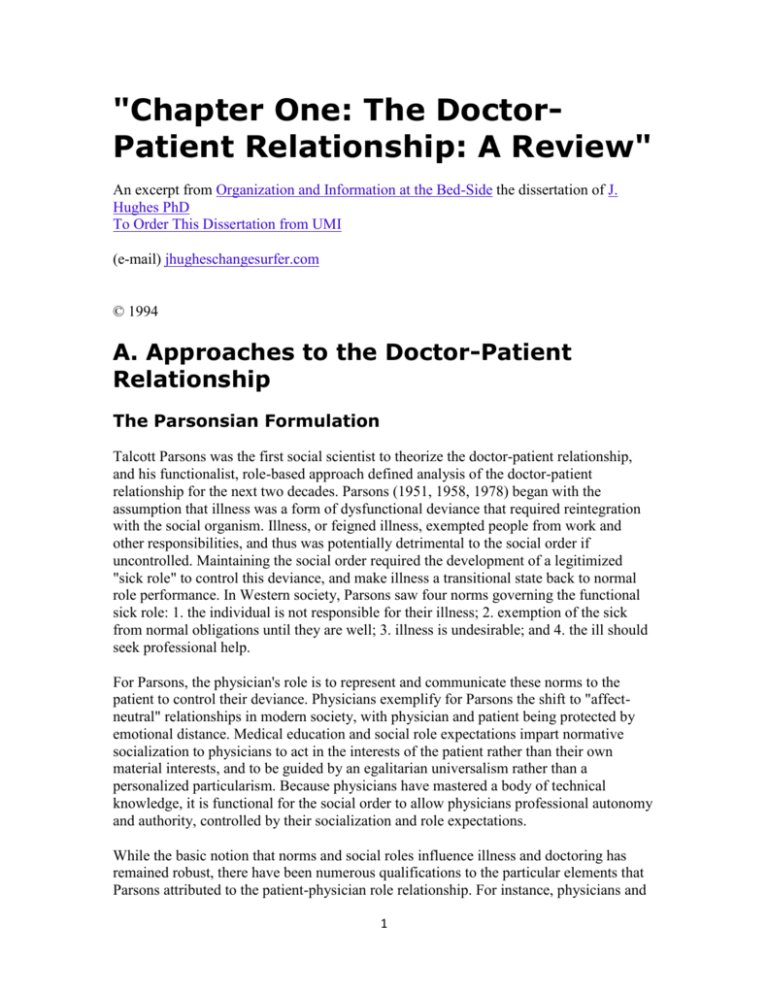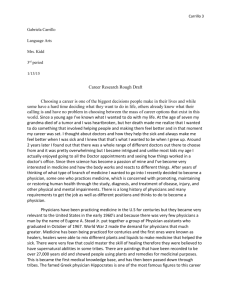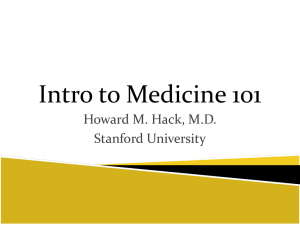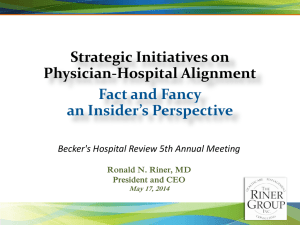A. Approaches to the Doctor-Patient Relationship
advertisement

"Chapter One: The DoctorPatient Relationship: A Review" An excerpt from Organization and Information at the Bed-Side the dissertation of J. Hughes PhD To Order This Dissertation from UMI (e-mail) jhugheschangesurfer.com © 1994 A. Approaches to the Doctor-Patient Relationship The Parsonsian Formulation Talcott Parsons was the first social scientist to theorize the doctor-patient relationship, and his functionalist, role-based approach defined analysis of the doctor-patient relationship for the next two decades. Parsons (1951, 1958, 1978) began with the assumption that illness was a form of dysfunctional deviance that required reintegration with the social organism. Illness, or feigned illness, exempted people from work and other responsibilities, and thus was potentially detrimental to the social order if uncontrolled. Maintaining the social order required the development of a legitimized "sick role" to control this deviance, and make illness a transitional state back to normal role performance. In Western society, Parsons saw four norms governing the functional sick role: 1. the individual is not responsible for their illness; 2. exemption of the sick from normal obligations until they are well; 3. illness is undesirable; and 4. the ill should seek professional help. For Parsons, the physician's role is to represent and communicate these norms to the patient to control their deviance. Physicians exemplify for Parsons the shift to "affectneutral" relationships in modern society, with physician and patient being protected by emotional distance. Medical education and social role expectations impart normative socialization to physicians to act in the interests of the patient rather than their own material interests, and to be guided by an egalitarian universalism rather than a personalized particularism. Because physicians have mastered a body of technical knowledge, it is functional for the social order to allow physicians professional autonomy and authority, controlled by their socialization and role expectations. While the basic notion that norms and social roles influence illness and doctoring has remained robust, there have been numerous qualifications to the particular elements that Parsons attributed to the patient-physician role relationship. For instance, physicians and 1 the public consider some illnesses in the West and in other societies to be the responsibility of the ill, such as lung cancer, AIDS and obesity, making it more difficult for them to be normatively reintegrated into society. Physicians and other providers react less favorably to patients who are held responsible for their illness than to "innocent" patients (e.g. Kelly, 1987). Parsons has also been accused of having been overly optimistic about the success of physician socialization to universalism and affective-neutrality. Physicians often react negatively to dying patients, patients they do not like, and patients they believe are complainers (Hafferty, 1988). Physicians also are subject to personal financial and personal interests in patient care. Another weakness of Parsons' description is that it was specific to acute illness, and did not speak to the increasingly prevalent chronic illnesses and disabilities, a sick role which is permanent and not transitional (Mechanic, 1959). Szasz and Hollender's (1956) work refined Parsons by elaborating different doctor-patient models arising around different types of illness. Szasz and Hollender proposed that patient passivity and physician assertiveness are the most common reactions to acute illness; less acute illness is characterized by physician guidance and patient cooperation; and chronic illness is characterized by physicians participating in a treatment plan where patients had the bulk of the responsibility to help themselves. Critics have also shown that there is a great deal of inter-cultural, and inter-personal variation in sick roles and norms. The "American" sick role is not as useful a concept as the more specific "white, Midwestern, Scandinavian, male" sick role. There is also crossclass variation. Some of the poor adapt to their lack of access to medical care by becoming fatalistic, rejecting the necessity of medical treatment, and coming to see illness and death as inevitable. On the other hand, the educated classes have become more assertive in the relationship, rejecting the norm of passivity in favor of self-diagnosis or negotiated diagnosis. Parsons also based his model of the doctor role on the assumption of a long-term relationship with a family physician. Growing medical specialization and the decline of the solo family practitioner makes this dyadic role model incomplete. Increasingly, several doctors attend various of a patient's ailments, each with a somewhat different set of role expectations and interpretations of the patient's role performance. Professionalization and Socialization There is also inter-cultural variation in physician roles, and variation among physicians in the success of their role socialization. While Parsons' model of doctors' affective neutrality, collective-orientation, and egalitarianism towards patients did express the professional ideal, some physicians are more affectively neutral than others. Following Parsons' lead, sociologists began to focus on the socialization of physicians and the factors in medical school and residency that facilitated or discouraged optimal role 2 socialization to doctor-patient relationships (Merton, Reader, and Kendall, 1957; Becker, Geer, Hughes and Strauss, 1961). This work generally took the division of labor in medicine for granted, and painted a more or less heroic picture of medical self-sacrifice. A few writers began to focus on aspects of the physician role and medical education that themselves militated against humanistic patient care. Critics suggested that medical schools and residencies socialized physicians into "dehumanization," and to place professional identity and camaraderie before patient advocacy and social idealism (Eron, 1955; Lief and Fox, 1963; and more recently Anspach, 1988; Hafferty, 1988; Sudit, 1988; Conrad, 1989). Professional Power and Autonomy The most important weakness of Parsons' functionalist account of the doctor-patient relationship, however, arose from his poor understanding of the ecological concepts of dysfunction and niche width. Social structures cannot be assumed to be functional for the social system simply because they exist, any more than an organic structure, such as an appendix, can be assumed to be functional for its organism. All that can be said about a structure, or in this case a role relationship, is that it has not yet pushed the organism outside its niche, causing its extinction. In other words, the study of doctor-patient relationships in one society does not indicate how much the particular structures and norms of the provider-patient relationship are simply the result of historical chance, rather than necessitated by the nature of illness and healing in industrial society. And second, such a study does not indicate whether the particular practices and norms are leading in a dysfunctional direction. A critical sociology of the doctor-patient relationship thus arose to challenge the internal contradictions of the Parsonsian biological metaphor: were American doctors the perfect immune system for society, or had they developed into a parasitic growth threatening the health of society? To the more critical 60's generation of social scientists, inspired by growing resistance to unjust claims to power, physicians' defense of professional power and autonomy appeared to be merely self-interested authoritarianism. Physicians' battle-cry of the sacred nature of the doctor-patient relationship sounded hollow in their struggles against universal health insurance. Physicians' high incomes and defense of autonomy appeared to result in both bad medicine and bad health policy, and physician's unaccountable power appeared all the more nefarious because of medicine's intimate invasion of the body, In this context, Eliot Freidson's work (1961, 1970, 1975, 1986) crystallized the notion that professional power was more self-interested than "collectivity-oriented." Freidson saw the doctor-patient relationship as a bargained interface between a professional system and a lay system, each with its own interests. Freidson's approach to the sick role was influenced by labeling theory (Szasz, 1961; Scheff, 1966), and went beyond Parsons to assert that doctors create the legitimate categories of illness. Professionalization grants 3 physicians a monopoly on the definition of health and illness, and they use this power over diagnosis to extend their control. This control extends beyond the claim to technical proficiency in medicine, to claims of authority over the organization and financing of health care, areas which have little to do with their training. There are now many studies of the way that professional power has been institutionalized in the structure and language of the doctor-patient relationship. For instance, a recent study of medical students' presentation of cases demonstrated that physicians were being trained to talk about their patients in a way that portrayed the physician as merely the vehicle of an impersonal medicine acting on malfunctioning organs, rather than a potentially fallible human being interacting with another human being. The more highly regarded presenters were found to 1) separate biological processes from the patient, 2) use the passive voice in describing interventions, 3) treat medical technology as the agent, and 4) mark patients' accounts as subjective (the patient "states," "reports," "denies,"). These devices make the physician more powerful by emphasizing technology and eliminating the agency of both physician and patient (Anspach, 1988). Since its publication, Starr's (1982) The Social Transformation of American Medicine has quickly become the canonical history of the institutionalization of professional power, its effect on the organization of health care, and the profession's metastasized influence in the political sphere. Though Starr draws on many theoretical sources, he paints a picture of the American doctor-patient relationship as a successful "collective mobility project" (Parry and Parry, 1976), whose contours were not at all determined by the functional prerequisites of society. While Starr does not goes so far as to say that we do not need "doctors" at all, he argues that there are a range of possible structures that medicine could have taken in industrial society, and that American physicians are an extreme within that range. Marxist and Feminist Approaches Drawing on, and extending the professional power analysts, the growing school of Marxist sociologists interpreted the doctor-patient relationship within the context of capitalism. In the Marxist analysis, the American doctor-patient relationship is conditioned by the "medical-industrial complex" (Ehrenreich and Ehrenreich, 1970; Waitzkin and Waterman, 1976; McKinlay, 1978; Waitzkin, 1986); profit-maximization drives the innovation of technologies and drugs and constrains physician decisionmaking. The most orthodox advocate of this analysis, Vincente Navarro (1974, 1986, 1987), rejects the analyses of those such as Illich (1975), Freidson and Starr who see professional power as having some autonomy from, and sometimes being in direct conflict with, capitalism and corporate prerogatives. For Navarro, physicians are both agents and victims of capitalist exploitation, engineers required to fix up the workers and send them back into community and work environments made dangerous and toxic by capitalism. But the professions are anomalous for traditional Marxist theory; only those who own the means of production are supposed to accrue occupational autonomy and great wealth. 4 This anomaly has led Marxist medical sociologists to propose the thesis of physician proletarianization (McKinlay & Arches, 1985). Theorists of physician proletarianization point to the rising numbers of salaried physicians, the deskilling of some medical tasks, and the shifting of some tasks from physicians to less skilled technical personnel. (I will examine the proletarianization/deprofessionalization thesis in greater detail below as it relates to the doctor-hospital relationship.) Parallel to, and often included in the Marxist account, has been the growing feminist literature on medicine. In particular, feminists have focused on the patriarchal nature of the male physician-female patient relationship, documenting the history of medical pseudo-science that has portrayed women as congenitally weak and in need of dubious treatments (Ehrenreich and English, 1972, 1973, 1978; Arms, 1975; Scully, 1980; Mendelsohn, 1981; Shorter, 1983; Corea, 1984; Fisher, 1986; Martin, 1987; Todd, 1989). There is also extensive work done on the history of exclusion of women from medicine (Walsh, 1977; Levitt, 1977; Achterberg, 1991), and the effects of the growing numbers of female doctors on the doctor-patient relationship. Women physicians tend to choose poorly paid primary care fields over the more lucrative, male-oriented surgical specialties, are more likely to be employed as opposed to in private practice, and are less likely to be in positions of authority (Martin, 1988). Women providers are also better communicators (Weisman and Teitelbaum, 1985; Shapiro, 1990). Economic Approaches The growth of studies on cost-containment, and the economistic trend of 1980's social science, led to the rise of methodologically individualistic "rational choice" studies of the doctor-patient relationship. These studies usually ignored the functionalists' interest in norms and roles, as well as the critical theorists' interest in power and exploitation. Instead, the economists' model starts from the assumption of a mutual "utilitymaximizing" agency contract between the doctor and patient (Dranove and White, 1987; Buchanan, 1988). The patient is interested in maximizing consumption of health, and the physician is interested in maximizing income. The studies then focus on the effects of insurance, reimbursement and utilization control structures on doctor behavior, the doctor-patient relationship and the success of medical agency (Eisenberg, 1986; Salmon and Feinglass, 1989). For instance, a number of studies have documented that patients without health insurance have less access to doctors, and receive less care from them when they have access (Hadley, Steinberg and Feder, 1991; Kerr and Siu, 1993). Research has also demonstrated that different payment structures affect physician behavior (Moreno, 1990; Rodwin, 1992). For instance, a recent study of Medicaid casemanagement found that pediatricians who received augmented Medicaid fees provided a higher volume of services to children than either a group receiving fees-for-service, or a group covered by capitation (Hohlen, et al., 1990). Another strain of economistic research picks up on the Freidson observation of physicians' power to define illness, and explores the degree to which physicians "induce demand." Induced demand theorists (Wennberg, Barnes and Zubkoff, 1982; Rice and 5 LaBelle, 1989) argue that physicians' financial incentives to treat, and patients' ignorance of their true needs, lead to inappropriate over-treatment. Communication and Outcomes Two trends led to the rapid growth of research on doctor-patient communication. The first trend was the interest of physicians and medical educators in improving their ability to elicit patient histories and concerns, and inform patients of their conditions and treatment needs, and thereby achieve successful diagnosis and treatment compliance. Literally thousands of analyses of consultations have been done since the 1950s to develop methods to teach and improve physician communication skills (Stewart and Roter, 1989). A second trend, the rise of health consumerism, has encouraged more contractual and conflictual relationships between patient and doctor. An increasingly well-educated population has begun to challenge medical authority, and treat the doctor-patient relationship as another provider-consumer relationship rather than as a sacred trust requiring awe and deference (Reeder, 1973; Haug and Lavin, 1983). Opinion polls indicate a steadily declining faith in physicians, and in the American medical system in general (Blendon, 1989). The consumer, women's health (Ruzek, 1978), the holistic health movements, and the perception of physician indifference and greed, have also encouraged patients to distrust physicians. These trends were often portrayed by medical sociologists as democratizing (Haug, 1976; Haug and Lavin, 1979, 1983), but perceived by physicians with alarm, especially in light of the rise of malpractice litigation. Encouraged by these two trends, symbolic interactionists (Anderson and Helm, 1979; Strauss, 1985) and discourse analysts began detailed analyses of doctor-patient communication to tease apart the workings of power and authority within them. In particular, Howard Waitzkin (1976, 1984, 1989, 1991) has drawn attention to the way that American medical communication reinforces individualistic, bio-medical interpretations of problems with social origins and social solutions, and thus reflects and reproduces social inequality and disenfranchisement. Another example is the work of Hayes-Bautista (1976) who studied the bargaining between the patient and the doctor over treatment. The patients were observed using "convincing tactics" of a) demands, b) disclosure that the treatment has not worked, c) suggestions, and d) leading questions. If these did not achieve the desired change in treatment, they turned to "countering tactics" of arguing that the treatment is too weak, too powerful or insufficient. To augment their authority, the doctors used tactics of a) wielding overwhelming knowledge, b) medical threats about the consequences of ignoring advice, c) disclosures that the treatment may take longer to work for the patient; or d) a personal appeal to the patient as an acquaintance. The outcome measures of this game theoretic situation were a) continuation of the relationship, b) patient termination of relationship, c) physician termination, and d) mutual termination. 6 Health care marketing became a third major impetus for studies of doctor-patient communication, largely with the goal of identifying the kinds of interactions that improved patient satisfaction. Research found, not surprisingly, that people like to have doctors talk to them in an egalitarian way, listen, ask a lot of questions, answer a lot of questions, explain things in a simple way that the patient can understand, and allow patients to make decisions about their care (DiMatteo, 1980; Hall, Roter and Katz, 1988; Roter, Hall and Katz, 1987, 1988; Roter and Hall, 1989; Gerteis, Edgman-Levitan, Daley and Delbanco, 1993). Researchers also began to demonstrate that different patterns of communication have effects on the clinical outcomes of patient care. The kinds of medical care that patients find satisfying tends to alleviate psychosomatic symptoms and make patients more compliant with their treatment regimes, and thereby produce better clinical outcomes (Egbert, et al., 1964; Greenfield, Kaplan and Ware, 1985; Greenfield, Kaplan, Ware, Yano and Frank, 1988; Kaplan, Greenfield and Ware, 1989). B. The Decline of the Professions and the Doctor-Patient Relationship To change the health system at all, much less to create a medical system which maximally utilizes self-help and mutual help and which encourages an active rather than a passive role for the patient, will require radical deprofessionalization. We will have to expand radically the use of community health aides; to spread medical knowledge to patients and to non-physician health workers; to minimize the social distance between doctors and patients. I should emphasize that deprofessionalization has nothing to do with eliminating the skills of the doctors. Skills are of course needed, and I am not proposing that incompetent people perform medical services-we have too much of that as it is! It is the privileges, the power, and the monopolization of medical knowledge that I am speaking of removing when I speak of deprofessionalization. (Ehrenreich and Ehrenreich, 1978: 70) Having access to a strong provider-patient relationship, with good participative communication, has been shown to be important for the experienced and objective quality of care. But a number of social trends have converged to reduce the ability of patients to have these relationships with physicians. The critical theorists, in turn, have raised questions about whether radically different relationships, with radically different providers of care, might be possible and preferable. Over-Specialization and the Decline of Primary Care One trend has been the rapid proliferation of specialization among American physicians. Only one in ten American physicians are in "general practice" (general or family practitioners, pediatricians and geriatricians), with a claim to a holistic approach to patients' concerns. Many researchers assume that increasing specialization will continue 7 to "technologize" and "compartmentalize" doctor-patient interaction. As patients see increasing numbers of poorly coordinated specialists for their myriad problems, the need for "case-managing" generalists becomes ever more acute. Declining Autonomy and Rise of the Organization Remaining independent of organizations, including insurance companies, unions and the government as well as hospitals, has been a consistent and explicit theme of physicians since the turn of the century. Professional autonomy and independence is the most important factor in their satisfaction with their worklife. One early study was Freidson and Mann's (1971) analysis of 1962 and 1963 data collected from physicians in the nation's large group practices. They performed a factor analysis on all the variables in the study, both organizational and attitudinal, and discovered eight factors. One of the factors they labeled "physician satisfaction," composed of several highly inter-correlated items: having little controversy among one's fellow physicians over the division of income, and having a small clerical and large paramedical staffs. This physician-pleasing constellation positively correlated with the "egalitarianism" of the firm, and negatively related to its "bureaucratization." Egalitarianism consisted of:< Physicians feel like they have a voice Small number of physicians in group Physicians not over-supervised Most physicians partners, not employees No formal chiefs of specialty departments Bureaucratization consisted of: A lot of formal offices Salaried physicians Written rules Written statement of # of hours to work A more recent national survey (Ku and Fisher, 1990) of 500 physician asked their views on 23 possible policies, and factor analyzed their responses into 2 general factors. Physicians favored policies that increased responsibilities and costs on patients, and disliked policies that decreased physician autonomy. Organizational variables associated 8 with autonomy were the strongest predictors of physician satisfaction. Another recent study, of German psychiatrists, again found managers' encouragement of participation, physician autonomy, supportive communication, and peer review activities were the best predictors of physician satisfaction (Schulz and Schulz, 1989). The desire for autonomy also effects physician behavior. Wholey and Burns (1991) analyzed the admitting patterns of 450 physicians and determined that there was evidence that physicians avoided admitting to hospitals at which they had reasons to fear loss of autonomy. Splintering along specialty lines, and facing challenges from nurse and patients, physicians are also increasingly constrained from above. Physicians are slowly moving from private practices towards employment in hospitals and HMOs. Today, less than half of all physicians are in private practice (Loft and Kletke, 1989). And as managed care networks grown, even solo practitioners are being forced to become "gatekeepers" for third party payors. Further threats to the traditional physician patient relationship "from above" come from the growing body of government regulations, and the growth of governmental payors. Today, nearly 50% of all health care dollars come from government sources, sources which have begun to assert their authority over health care through innovations such as "diagnostic related groups" (DRGs) and "resource-based reimbursement value systems" (RBRVS). Under the constraints of cost-containment, and with the rise of new technologies, the traditional divisions of labor in medicine are being challenged. Questions are being raised about which tasks actually require the knowledge of a physician, much less a specialist physician, and which could be delegated to less skilled, but far more manageable, paraprofessionals. An even more fundamental challenge to physician authority and expertise is emerging out of research into diagnostic reasoning and practice protocols. To the extent that the best diagnostic and treatment knowledge and reasoning can be programmed into a computer, and used to monitor computerized patient records, the work of any physician or organization of physicians can be matched and surpassed. The inevitability of physicians going the way of John Henry was seriously articulated in a visionary 1976 volume by Jerrold Maxmen titled The Post-Physician Era. Maxmen argued that eventually all medical diagnostic and treatment decision-making, the core of the physician role, would be done better by computers. When this came to be, doctors would no longer be necessary, but rather "medics," a hithero unknown type of health care professional, would provide the supportive and some of the technical tasks currently being performed by doctors. Because a medic-computer symbiosis would usurp all of the tasks presently assigned to 9 physicians, doctors would be rendered obsolete...This model is a feasible, probable, and desirable alternative future. (Maxmen, 1975) Summary: Continuity, Trust, and Communication Do Matter, But Perhaps Doctors Do not Patients will probably continue to demand a specific human face on the medical care they receive (Barnard, 1988). But the question that has been rarely asked is whether that face must be a physician's. In the following section I will review trends in the organization of hospitals and health care that make possible and probable the substitution of nurses for physicians in a variety of tasks, backed by complex organizations and information systems. jhughes@changesurfer.com This page: http://www.changesurfer.com/Hlth/DPReview.html 10







